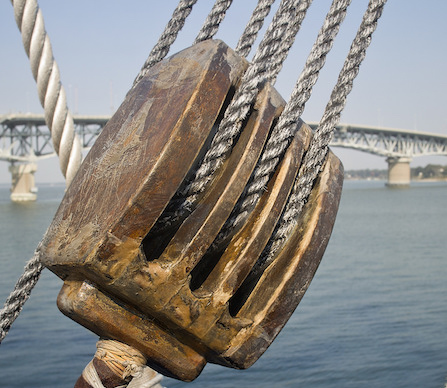Load transfer: The alpine block and tackle
This is part of a series of articles that cover methods to move a large load a short distance, typically to unweight an anchor.
If you tie your cordelette “bunny ears” style, as I recommend in this Tip, you can make a low-tech block and tackle system. #CraftyRopeTrick for sure!
(History side note: The term “block” comes from the wooden blocks that were originally used on ships to raise heavy sails, and the “tackle” refers to the ropes/rigging running between the blocks.)
Climbers typically think that mechanical advantage systems only come into play in a rescue-type scenario. But there are some other situations where they can come in handy.
When might you want to use an alpine block and tackle?
In general, to move a large load a very short distance.
Maybe you're in some other kind of rescue scenario, and you need to momentarily lift a load off of a carabiner an inch or two to unclip something.
Maybe you're on a big wall climb, you screwed up your rigging somehow, and you need to lift your haul bag a few inches to get it unclipped. (Note, if you use a docking cord to attach your haul bag to the anchor, you should never have this problem.) See image below.
You have a strand of rope with a weighted knot, and you need to unweight the rope so you can untie the knot. To do this, put prusik loops above and below the knot, and rig the block and tackle between the two prusiks. See image below.
In the example shown in the video below, you can transfer or share the load in a crevasse rescue off a sketchy initial gear placement to a stronger second placement.
Note: I tested a 6:1 theoretical alpine block and tackle system with a spring scale. My results show a real world mechanical advantage of about 1.8 to 1. (Round that to 2 to 1 if you like, easier to remember.) Perhaps helpful, but a long way from 6:1!
Here are a couple of nice illustrations from Climbing magazine that show some possible uses for the alpine block and tackle. (Drawings by the amazingly talented Mike Clelland.)
image: CLIMBING magazine, illustration Mike Clelland
image: CLIMBING magazine, illustration Mike Clelland
Here's an interesting application for using this tool to equalize anchors for a crevasse rescue.
In the crevasse rescue video below, the guide makes an initial quick anchor. He then adds another stronger picket, and uses the alpine block and tackle to share the load with the new stronger picket. Crafty!
The block and tackle part starts at 2:20.
The video covers things pretty well, but below is a step-by-step with some photos.
A few things to note:
To make the math simple, for the example below let’s assume a load of 100 pounds.
Try to use an HMS pear shaped belay carabiner. These tend to be wide and flat-ish on the bottom, which minimizes the friction of the cord rubbing against itself.
You could probably use a double length/120 cm dyneema runner to accomplish this also, but the bunny ears cordelette is overall going to be easier.
Every loop you put through the LOAD carabiner increases your theoretical mechanical advantage by a factor of two. One loop gives you a 2 to 1, the second loop gives you a 4 to 1, the third loop gives you a 6 to 1.
Every loop that you put through the ANCHOR carabiner does nothing to increase your mechanical advantage. This only is redirecting the pull.
Every change of rope direction adds friction that robs you of pulling force. While it varies depending on carabiner size and rope diameter, pulling a rope over a carabiner results in roughly a 50% efficiency loss. (This is easiest to notice when you compare picking up a 100 lb weight vs simply redirecting it through a carabiner. Much harder to lift it through a redirect right?) So, this theoretical 6:1 is actually about 2:1 in real life. (Yes, I tested it.)
In the real world with an improvised system like this, you probably don’t want to start going past about a 6 to 1, because all of the increased friction really starts to diminish your mechanical advantage. (Besides, you will run out of cord at some point.)
But, for the situations mentioned above, such as transferring the load in a crevasse rescue to a new anchor, or lifting up your haul bag off the anchor a few inches so you can unweight a carabiner, the approximate 2:1 real world MA might be the boost you need.
If you need to lift something seriously heavy, like a loaded haul bag or person, you may need to add a sort of extension or even a loop so you can stand in it and give it your full bodyweight.
Use a cordelette tied “bunny ears” style, with a single 5-6 meter strand of 6-7 mm cord. with two small bight knots in either end.






